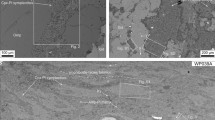Abstract
Sphene and zircon are common accessory minerals in metamorphic and igneous rocks of very different composition from many different geological environments. Their essential structural constituents, Ti and Zr, are capable of replacing each other to some degree. In this paper we detail the results of high pressure–temperature experiments as well as analyses of natural sphene crystals that establish a systematic relationship between temperature, pressure and Zr concentration in sphene. Calibrations of the temperature and pressure relationships are presented as a thermobarometer. Synthetic sphene crystals were crystallized in the presence of zircon, quartz and rutile at 1–2.4 GPa and 800–1,000°C from hydrothermal solutions. Crystals were analyzed for Zr by electron microprobe (EMP). The experimental results define a log-linear relationship between equilibrium Zr content (ppm by weight), pressure (GPa) and reciprocal absolute temperature: \( {\text{log}}({\text{Zr}}^{{{\text{sphene}}}} ,{\text{ppm}}) = 10.52( \pm 0.10) - \frac{{7708( \pm 101)}} {{T(K)}} - 960( \pm 10)\frac{{P({\text{GPa}})}} {{T(K)}} - {\text{log}}(a_{{{\text{TiO}}_{2} }} ) - \log (a_{{{\text{SiO}}_{2} }} ). \)The incorporation of Zr into sphene was found to be rather sensitive to pressure effects and also to the effects of kinetic disequilibrium and growth entrapment that result in sector zoning. The Zr content of sphene is relatively insensitive to the presence of both REEs and F-Al substitutions in sphene. To supplement and test the experimental data, sphenes from seven rocks of well-constrained origin were analyzed for Zr by both EMP and ion microprobe (IMP). The sphene thermobarometer records crystallization temperatures that are consistent with independent thermometry. When applied to natural sphene of unknown origin or growth conditions, this thermobarometer has the potential to estimate temperatures with an approximate uncertainty of ±20°C over the temperature range of interest (600–1,000°C). The Zr-in-sphene thermobarometer can also be used in conjunction with the Zr-in-rutile thermobarometer to estimate both pressure and temperature of crystallization.









Similar content being viewed by others
Notes
An alternative method is to combine the TitaniQ and TiO2 solubility equations to create an equation for temperature that depends only on Ti content of quartz and Ti content and composition of the host glass. However, there are relatively large errors associated with this approach due to the similarity of the slopes for the equations describing Ti solubility in quartz and in melts. Another alternative is to simultaneously solve the Zr-in-sphene (for a given P) and TitaniQ equations for both temperature and \( a_{{{\text{TiO}}_{{\text{2}}} }} ; \) this approach assumes that sphene and quartz crystallized at the same temperature.
References
Bachmann O, Dungan MA, Lipman PW (2002) The Fish Canyon magma body, San Juan volcanic field, Colorado: rejuvenation and eruption of an upper-crustal batholith. J Petrol 43:1469–1503
Castelli D, Rubatto D (2002) Stability of Al- and F-rich titanite in metacarbonate: petrologic and isotopic constraints from a polymetamorphic eclogitic marble of the internal Sesia Zone (Western Alps). Contrib Mineral Petrol 142:627–639
Cherniak DJ (2006) Zr diffusion in titanite. Contrib Mineral Petrol 152:639–647
Ferry JM, Watson EB (2007) New thermodynamic models and revised calibrations for the Ti-in-zircon and Zr-in-rutile thermometers. Contrib Min Pet. doi 10.1007/s00410-007-0201-0
Franz G, Spear FS (1985) Aluminous titanite (sphene) from the Eclogite Zone, south-central Tauern Window, Austria. Chem Geol 50:33–46
Hayden LA, Watson EB (2007) Rutile saturation in hydrous siliceous melts and its bearing on Ti-thermometry of quartz and zircon. Earth Planet Sci Lett 258:561–568
Hickmott DD, Sorensen SS, Rogers PSZ (1992) Metasomatism in a subduction complex: constraints from microanalysis of trace elements in minerals from garnet amphibolite from the Catalina Schist. Geology 20:347–350
Higgins JB, Ribbe PH (1976) The crystal chemistry and space groups of natural and synthetic titanites. Am Mineral 61:878–888
Knoche R, Angel RJ, Seifert F, Fliervoet TF (1998) Complete substitution of Si for Ti in titanite Ca(Ti1-xSix)VISiIVO5. Am Mineral 83:1168–1175
Kunz M, Alrt T, Stolz J (2000) In situ powder diffraction study of titanite (CaTiOSiO4) at high pressure and high temperature. Am Mineral 85:1465–1473
Pyle JM (2006) Temperature–time paths from phosphate accessory phase paragenesis in the Honey Brook Upland and associated cover sequence, SE Pennsylvania, USA. Lithos 88:201–232
Ribbe PH (1980) Titanite. Rev Mineral 5:137–154
Sorensen SS, Grossman JN (1989) Enrichment of trace elements in garnet amphibolites from a paleo-subduction zone: Catalina Schist, southern California. Geochim Cosmochim Acta 53:3155–3177
Speer JA, Gibbs GV (1976) The crystal structure of synthetic titanite, CaTiOSiO4, and the domain textures of natural titanites. Am Mineral 61:238–247
Tomkins HS, Powell R, Ellis DJ (2007) The pressure dependence of the zirconium-in-rutile thermometer. J Metamorphic Geol 25:703–713
Wark DA, Watson EB (2006) TitaniQ: a titanium-in-quartz geothermometer. Contrib Mineral Petrol 152:743–754
Watson EB (2004) A conceptual model for near-surface kinetic controls on the trace-element and stable isotope composition of abiogenic calcite crystals. Geochim Cosmochim Acta 68:1473–1488
Watson EB, Liang Y (1995) A simple model for sector zoning in slowly grown crystals: implications for growth rate and lattice diffusion, with emphasis on accessory minerals in crustal rocks. Am Mineral 80:1179–1187
Watson EB, Wark DA, Thomas JB (2006) Crystallization thermometers for zircon and rutile. Contrib Mineral Petrol 151:413–433
Acknowledgments
This work was supported by NSF grant no. EAR-0440228 grant to E. B. Watson. The authors wish to thank Graham D. Layne for his assistance with the ion microprobe, Eric H. Christiansen for providing us with samples, and John Ferry and Gerhard Franz for their helpful reviews of this manuscript.
Author information
Authors and Affiliations
Corresponding author
Additional information
Communicated by T.L. Grove.
Electronic supplementary material
Below is the link to the electronic supplementary material.
Rights and permissions
About this article
Cite this article
Hayden, L.A., Watson, E.B. & Wark, D.A. A thermobarometer for sphene (titanite). Contrib Mineral Petrol 155, 529–540 (2008). https://doi.org/10.1007/s00410-007-0256-y
Received:
Accepted:
Published:
Issue Date:
DOI: https://doi.org/10.1007/s00410-007-0256-y




